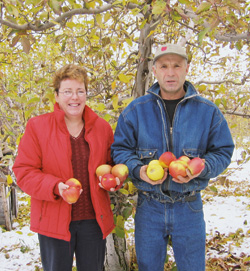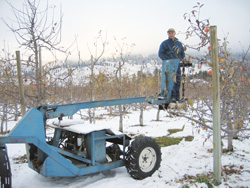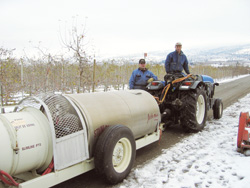
Features
Production
Research
B.C. Golden Apple Award winners share their views about apples
April 1, 2008 By Wendy Johnson
Peel back the layers of a Golden
Apple Award winner and at the core there’s a farmer who knows how to
coax the best from his land and his crop.
 |
| Adelia (left) & Jack Machial with a sample of their 2005 crop. Photo by Wendy Johnson |
Peel back the layers of a Golden Apple Award winner and at the core there’s a farmer who knows how to coax the best from his land and his crop.
Jack Machial is the latest British Columbia grower to earn the coveted award recognizing excellence in tree fruit production practices, presented annually during the B.C. Fruit Growers’ Association’s (BCFGA) two-day Horticultural Forum, held in November.
Jack and his wife, Adelia, farm 13 acres – 10 of them planted to apples – in the Okanagan, a sinuous desert valley in south-central B.C. owned by the summer sun and tweaked by seasonal precipitation into a tapestry of small orchards, vineyards and ground crop acreages.
Their’s is a family operation on the rural upslopes outside the town of Oliver in the South Okanagan, planted to a mixture of standard and new variety apples, as well as early and late cherries and some Italian plums thrown in for good measure.
 |
| Jack Machial on the farm’s giraffe. These handy machines are becoming rare in the Okanagan as growers replant to high-density super spindle trees. Photo by Wendy Johnson |
 |
| Jack Machial (on tractor) and his son Edward. Photo by Wendy Johnson |
A fifth-generation farmer whose family immigrated to Canada from Portugal when he was 12, Machial has that combination of characteristics imperative in today’s agricultural climate – an innate sense of his land’s capabilities, balanced by a willingness to embrace the cutting-edge of market trends, and a ruthlessness to remove trees not pulling their profit weight.
And with 617 bins of apples going this year to the local Okanagan Similkameen Cooperative Growers’ Association packinghouse, where he sells all his fruit, Jack’s qualifiers are simple and succinct.
“I want top quality fruit and top yields, so I do analyses all the time on my blocks and if the apple doesn’t produce a certain amount of money per acre, it’s gone.”
It was this philosophy that pushed the couple into high-density plantings under the provincial government’s continuing Replant Program, a move that altered both the appearance of their orchard and their production methods. Barely 10 per cent of his huge, gnarled, wide-crowned standard trees remain; in their places stand phalanxes of Gala, Ambrosia, Fuji, Braeburn and Sunrise, plus some test trees of Aurora Golden Gala, Honeycrisp, Early Fuji and Cripps Pink (called Pink Lady in the U.S.). Planted 2,400 trees to the acre, these lean, upright trunks are waist-high to a picker’s ladder, their central leaders flanked by sparse stubby limbs called dards.
The same mindset made him rip out his newer blocks of Jonagolds when they failed to thrive under the hot Okanagan sun.
But he refuses to part with his Golden Delicious trees flourishing on their one-and-a-half-acre block. Their consistent tonnage – 100 bins this fall – coupled with easy maintenance, ensures its longevity in Machial’s orchard.
He is reserving judgment on his test trees, though. Honeycrisp apples seem to prefer cooler temperatures and higher humidity than desert norms and they are subject to bitter pit – a flaw Jack fights with the application of eight to 12 calcium sprays. And his Auroras are developing russet on the skins, a blemish scorned in a marketplace demanding visual perfection.
However, the Cripps Pink did well this year because the season was an extra long one, but it is a finicky fruit this far north of its usual habitat, so he doesn’t set great store by it. The Early Fuji is faring well and should be a good apple for growers who want to jump-start consumer demand by short-circuiting their purchase of earlier American varieties of this apple.
In his high-density sector, Machial’s choice of M-9 dwarf rootstock – 80 per cent of his plantings are on this hardy variety after an earlier foray into M-26s – echoes that of other Okanagan growers. Here soils range from rich heavy loam to rocky, depending on location.
While prolific in this climate, M-9s do have a dependency – they must be supported by a trellis system strong enough to withstand windstorms. Jack uses post-and-wire on trees planted at 10 feet and 18 inches apart – four wires on 10-foot posts, pounded two feet into the ground.
“Windstorms can be costly because they will find every loose wire and unsupported post,” he said ruefully. “Don’t skimp on support systems because if a gripple slips and a tree goes down, it will take the whole row with it.”
The lack of protective canopies and more shallow root systems in these trees invite sunburn, a threat Machial keeps at bay with an efficient irrigation system. Although he still uses a Rainbird on his Goldens, he has installed micro-sprinklers in the replanted blocks and monitors a weather station on his property for wind and rainfall measurements.
“It’s all about knowing your soil’s water needs and watering accordingly. But keeping grass between the rows helps too, since the cover can lower the temperature in the orchard by five to 100C. During the hottest months, I let the grass grow long to prevent burning on the bottoms of the apples.”
High-density trees require different pruning techniques, too. Machial keeps his few branches short and ensures they stay within a minimum of 50 per cent of the leader’s diameter.
It is a task that spans the year. Winter means branch removal and letting temperature dictate pruning times to avoid splintering the wood; spring calls for a repetition of the procedure if
necessary. Starting in early August with Sunrise apples, he does a heavy summer pruning to encourage light penetration for higher grades, or if the apples are big already, then follows the process through the varieties until mid-September in his Fuji blocks.
“You have to know when to prune,” noted Adelia. “If you do it too early you will lose size.”
Pests like aphids are less of a problem here than in other regions, thanks in part to the dry climate, while the ongoing Sterile Insect Release (SIR) program has seriously curtailed a codling moth’s ability to reproduce.
“SIR is technology that works. I have not had to spray for codling moth for the last 10 years. Now my biggest pest is the Oblique Banded Leaf Roller and for that I use B-t sprays in the spring – at bloom and a follow-up 10 days later.”
A firm believer in Integrated Pest Management who also sits on the BCFGA’s IPM committee, Machial encourages beneficials like lacewings, ladybugs, earwigs, earthworms and spiders to keep his orchard in balance, and won’t use sprays that interfere with this process.
“Whenever I go into the orchard and see worm castings I know it’s a sign the soil is healthy.”
Similarly, the desert air cuts down on the need for fungicides, since there are less weather-related incidences of scab and mildew here.
A replant program that virtually eliminates the need for broadcast spray methods; an SIR program that effectively kills codling moth; and soft management technologies that promotes clean healthy fruit – sounds like a grower’s paradise.
It is, but the Machials are worried about the future of agriculture for their three children – Christina, Edward, and Melissa. Developers are gobbling up land like there is no tomorrow, putting pressure on remaining farmers.
“I have nothing against growth, but when we lose the ability to feed ourselves, what will happen?” asked Adelia. “There hasn’t been a lot of hunger in this part of the world; people go to the store and the food is always there and they forget it has to come from somewhere.”
Print this page